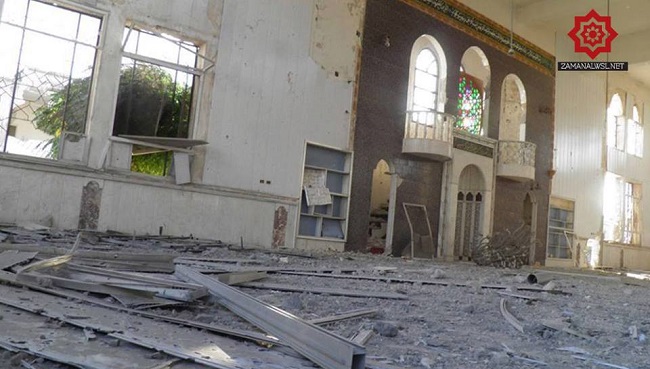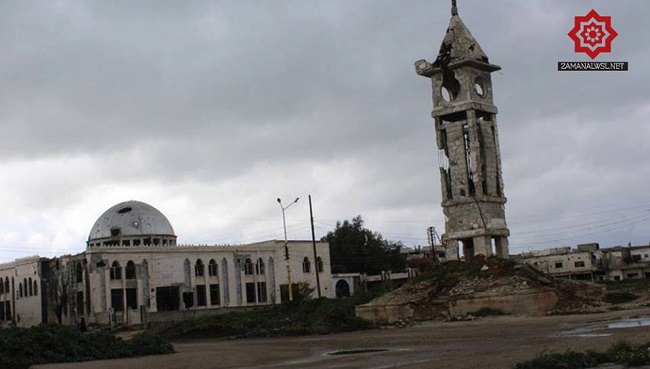Translation by Yusra Ahmed
(Zaman Al Wasl)- Al Houla region in the northwest countryside of Homs province was one of the first towns which came out in peaceful demonstration and they were the biggest gatherings.
Zaman Al Wasl tried on the 5th anniversary of the Syrian revolution to examine what happened to mosques and squares those where the starting points for peaceful demonstrations.
According to sources that Holeh’s towns and villages have almost 20 mosques, five of them used to be the start for huge peaceful demonstration after Friday prayer, then they used to head toward Martyrs mosque and Addawar Square in Taldo town, the biggest in al Houla.
Sources added the regime’s militias had invaded the town in August 2011, and they used houses around Horiyah square as military points an they destruct the mosque nearby and prevented people from praying in it.

Abo Annor, a media activist and one of the revolution’s chanters said that the old mosque and al-Farouq Mosque in Kafr-Laha were the first to target in mortars shelling, as well as squares used for demonstrating in Taldo and Mokhtar Square.
Abo Annor confirmed that most squares in al Houla town were shelled in bombed with heavy and medium size weapon beside targeting mosques especially in the third year of the revolution by rocket and explosive barrels.
Statistics done by some civil organization showed that almost 100 mosques in Homs were destroyed by the Syrian regime and its militias, and even a mosque in Halmooz in North countryside of Homs was bombed by the Russian warplanes in last February and was completely demolished.

The statistics explained that some mosques were completely destroyed, while others partially, and till now no restoration was done except Khalid Bin Al-Walid mosque in Homs city, as the Syrian regime started restoring it last year to prove that the armed gangs which had destroyed it.
The Syrian Revolution started in March 2011 with nationwide anti-government protests, and clashes between security forces and protestors in Homs were intensified in April In early May 2011, the Syrian military conducted a crackdown against anti-government protesters in Homs, some of whom were armed and fired on security forces.
Rebels-held areas in Homs were seized by the Syrian regime. The siege lasted three years from May 2011 to May 2014 and resulted in an opposition withdrawal from the city.
On May 25, 2012 the Syrian regime and its militias committed a massacre against people in the town of al Houla killing 180 people according to UN figures, majority of them children, women and elderly. About 108 victims were brutally killed with knives, axes and guns, while the rest were killed as a result of mortar shelling.
The Syrian revolution enters its 6th year, with more than 300 thousand deaths and more than 10 millions left their areas and houses.
(Zaman Al Wasl)- Al Houla region in the northwest countryside of Homs province was one of the first towns which came out in peaceful demonstration and they were the biggest gatherings.
Zaman Al Wasl tried on the 5th anniversary of the Syrian revolution to examine what happened to mosques and squares those where the starting points for peaceful demonstrations.
According to sources that Holeh’s towns and villages have almost 20 mosques, five of them used to be the start for huge peaceful demonstration after Friday prayer, then they used to head toward Martyrs mosque and Addawar Square in Taldo town, the biggest in al Houla.
Sources added the regime’s militias had invaded the town in August 2011, and they used houses around Horiyah square as military points an they destruct the mosque nearby and prevented people from praying in it.

Abo Annor, a media activist and one of the revolution’s chanters said that the old mosque and al-Farouq Mosque in Kafr-Laha were the first to target in mortars shelling, as well as squares used for demonstrating in Taldo and Mokhtar Square.
Abo Annor confirmed that most squares in al Houla town were shelled in bombed with heavy and medium size weapon beside targeting mosques especially in the third year of the revolution by rocket and explosive barrels.
Statistics done by some civil organization showed that almost 100 mosques in Homs were destroyed by the Syrian regime and its militias, and even a mosque in Halmooz in North countryside of Homs was bombed by the Russian warplanes in last February and was completely demolished.

The statistics explained that some mosques were completely destroyed, while others partially, and till now no restoration was done except Khalid Bin Al-Walid mosque in Homs city, as the Syrian regime started restoring it last year to prove that the armed gangs which had destroyed it.
The Syrian Revolution started in March 2011 with nationwide anti-government protests, and clashes between security forces and protestors in Homs were intensified in April In early May 2011, the Syrian military conducted a crackdown against anti-government protesters in Homs, some of whom were armed and fired on security forces.
Rebels-held areas in Homs were seized by the Syrian regime. The siege lasted three years from May 2011 to May 2014 and resulted in an opposition withdrawal from the city.
On May 25, 2012 the Syrian regime and its militias committed a massacre against people in the town of al Houla killing 180 people according to UN figures, majority of them children, women and elderly. About 108 victims were brutally killed with knives, axes and guns, while the rest were killed as a result of mortar shelling.
The Syrian revolution enters its 6th year, with more than 300 thousand deaths and more than 10 millions left their areas and houses.
















Comments About This Article
Please fill the fields below.